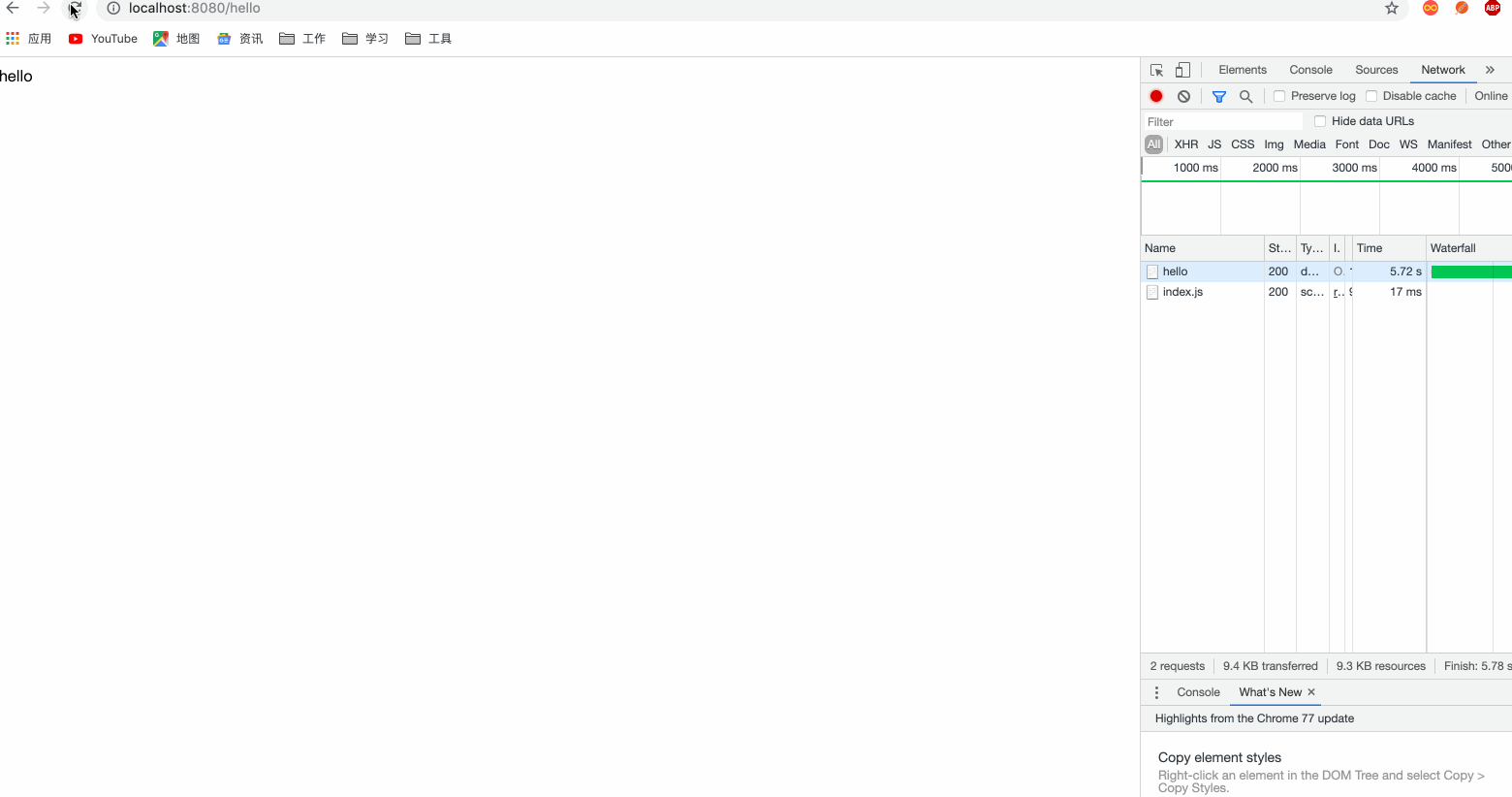前言
通過我之前的Tomcat系列文章,相信看我博客的同學對Tomcat應該有一個比較清晰的了解了,在前幾篇博客我們討論了Tomcat在SpringBoot框架中是如何啟動的,討論了Tomcat的內部組件是如何設計以及請求是如何流轉的,那么我們這邊博客聊聊Tomcat的異步Servlet,Tomcat是如何實現異步Servlet的以及異步Servlet的使用場景。
手擼一個異步的Servlet
我們直接借助SpringBoot框架來實現一個Servlet,這里只展示Servlet代碼:
@WebServlet(urlPatterns = "/async",asyncSupported = true)
@Slf4j
public class AsyncServlet extends HttpServlet {
ExecutorService executorService =Executors.newSingleThreadExecutor();
@Override
protected void doGet(HttpServletRequest req, HttpServletResponse resp) throws ServletException, IOException {
//開啟異步,獲取異步上下文
final AsyncContext ctx = req.startAsync();
// 提交線程池異步執行
executorService.execute(new Runnable() {
@Override
public void run() {
try {
log.info("async Service 準備執行了");
//模擬耗時任務
Thread.sleep(10000L);
ctx.getResponse().getWriter().print("async servlet");
log.info("async Service 執行了");
} catch (IOException e) {
e.printStackTrace();
} catch (InterruptedException e) {
e.printStackTrace();
}
//最后執行完成后完成回調。
ctx.complete();
}
});
}
上面的代碼實現了一個異步的Servlet,實現了 doGet 方法注意在SpringBoot中使用需要再啟動類加上 @ServletComponentScan 注解來掃描Servlet。既然代碼寫好了,我們來看看實際運行效果。

我們發送一個請求后,看到頁面有響應,同時,看到請求時間花費了10.05s,那么我們這個Servlet算是能正常運行啦。有同學肯定會問,這不是異步servlet嗎?你的響應時間并沒有加快,有什么用呢?對,我們的響應時間并不能加快,還是會取決于我們的業務邏輯,但是我們的異步servlet請求后,依賴于業務的異步執行,我們可以立即返回,也就是說,Tomcat的線程可以立即回收,默認情況下,Tomcat的核心線程是10,最大線程數是200,我們能及時回收線程,也就意味著我們能處理更多的請求,能夠增加我們的吞吐量,這也是異步Servlet的主要作用。
異步Servlet的內部原理
了解完異步Servlet的作用后,我們來看看,Tomcat是如何是先異步Servlet的。其實上面的代碼,主要核心邏輯就兩部分, final AsyncContext ctx = req.startAsync(); 和 ctx.complete(); 那我們來看看他們究竟做了什么?
public AsyncContext startAsync(ServletRequest request,
ServletResponse response) {
if (!isAsyncSupported()) {
IllegalStateException ise =
new IllegalStateException(sm.getString("request.asyncNotSupported"));
log.warn(sm.getString("coyoteRequest.noAsync",
StringUtils.join(getNonAsyncClassNames())), ise);
throw ise;
}
if (asyncContext == null) {
asyncContext = new AsyncContextImpl(this);
}
asyncContext.setStarted(getContext(), request, response,
request==getRequest() && response==getResponse().getResponse());
asyncContext.setTimeout(getConnector().getAsyncTimeout());
return asyncContext;
}
我們發現 req.startAsync(); 只是保存了一個異步上下文,同時設置一些基礎信息,比如 Timeout ,順便提一下,這里設置的默認超時時間是30S,也就是說你的異步處理邏輯超過30S后就會報錯,這個時候執行 ctx.complete(); 就會拋出IllegalStateException 異常。
我們來看看 ctx.complete(); 的邏輯
public void complete() {
if (log.isDebugEnabled()) {
logDebug("complete ");
}
check();
request.getCoyoteRequest().action(ActionCode.ASYNC_COMPLETE, null);
}
//類:AbstractProcessor
public final void action(ActionCode actionCode, Object param) {
case ASYNC_COMPLETE: {
clearDispatches();
if (asyncStateMachine.asyncComplete()) {
processSocketEvent(SocketEvent.OPEN_READ, true);
}
break;
}
}
//類:AbstractProcessor
protected void processSocketEvent(SocketEvent event, boolean dispatch) {
SocketWrapperBase<?> socketWrapper = getSocketWrapper();
if (socketWrapper != null) {
socketWrapper.processSocket(event, dispatch);
}
}
//類:AbstractEndpoint
public boolean processSocket(SocketWrapperBase<S> socketWrapper,
SocketEvent event, boolean dispatch) {
//省略部分代碼
SocketProcessorBase<S> sc = null;
if (processorCache != null) {
sc = processorCache.pop();
}
if (sc == null) {
sc = createSocketProcessor(socketWrapper, event);
} else {
sc.reset(socketWrapper, event);
}
Executor executor = getExecutor();
if (dispatch && executor != null) {
executor.execute(sc);
} else {
sc.run();
}
return true;
}
所以,這里最終會調用 AbstractEndpoint 的 processSocket 方法,之前看過我前面博客的同學應該有印象, EndPoint 是用來接受和處理請求的,接下來就會交給 Processor 去進行協議處理。
類:AbstractProcessorLight
public SocketState process(SocketWrapperBase<?> socketWrapper, SocketEvent status)
throws IOException {
//省略部分diam
SocketState state = SocketState.CLOSED;
Iterator<DispatchType> dispatches = null;
do {
if (dispatches != null) {
DispatchType nextDispatch = dispatches.next();
state = dispatch(nextDispatch.getSocketStatus());
} else if (status == SocketEvent.DISCONNECT) {
} else if (isAsync() || isUpgrade() || state == SocketState.ASYNC_END) {
state = dispatch(status);
if (state == SocketState.OPEN) {
state = service(socketWrapper);
}
} else if (status == SocketEvent.OPEN_WRITE) {
state = SocketState.LONG;
} else if (status == SocketEvent.OPEN_READ){
state = service(socketWrapper);
} else {
state = SocketState.CLOSED;
}
} while (state == SocketState.ASYNC_END ||
dispatches != null && state != SocketState.CLOSED);
return state;
}
這部分是重點, AbstractProcessorLight 會根據 SocketEvent 的狀態來判斷是不是要去調用 service(socketWrapper) ,該方法最終會去調用到容器,從而完成業務邏輯的調用,我們這個請求是執行完成后調用的,肯定不能進容器了,不然就是死循環了,這里通過 isAsync() 判斷,就會進入 dispatch(status) ,最終會調用 CoyoteAdapter 的 asyncDispatch 方法
public boolean asyncDispatch(org.apache.coyote.Request req, org.apache.coyote.Response res,
SocketEvent status) throws Exception {
//省略部分代碼
Request request = (Request) req.getNote(ADAPTER_NOTES);
Response response = (Response) res.getNote(ADAPTER_NOTES);
boolean success = true;
AsyncContextImpl asyncConImpl = request.getAsyncContextInternal();
try {
if (!request.isAsync()) {
response.setSuspended(false);
}
if (status==SocketEvent.TIMEOUT) {
if (!asyncConImpl.timeout()) {
asyncConImpl.setErrorState(null, false);
}
} else if (status==SocketEvent.ERROR) {
}
if (!request.isAsyncDispatching() && request.isAsync()) {
WriteListener writeListener = res.getWriteListener();
ReadListener readListener = req.getReadListener();
if (writeListener != null && status == SocketEvent.OPEN_WRITE) {
ClassLoader oldCL = null;
try {
oldCL = request.getContext().bind(false, null);
res.onWritePossible();//這里執行瀏覽器響應,寫入數據
if (request.isFinished() && req.sendAllDataReadEvent() &&
readListener != null) {
readListener.onAllDataRead();
}
} catch (Throwable t) {
} finally {
request.getContext().unbind(false, oldCL);
}
}
}
}
//這里判斷異步正在進行,說明這不是一個完成方法的回調,是一個正常異步請求,繼續調用容器。
if (request.isAsyncDispatching()) {
connector.getService().getContainer().getPipeline().getFirst().invoke(
request, response);
Throwable t = (Throwable) request.getAttribute(RequestDispatcher.ERROR_EXCEPTION);
if (t != null) {
asyncConImpl.setErrorState(t, true);
}
}
//注意,這里,如果超時或者出錯,request.isAsync()會返回false,這里是為了盡快的輸出錯誤給客戶端。
if (!request.isAsync()) {
//這里也是輸出邏輯
request.finishRequest();
response.finishResponse();
}
//銷毀request和response
if (!success || !request.isAsync()) {
updateWrapperErrorCount(request, response);
request.recycle();
response.recycle();
}
}
return success;
}
上面的代碼就是 ctx.complete() 執行最終的方法了(當然省略了很多細節),完成了數據的輸出,最終輸出到瀏覽器。
這里有同學可能會說,我知道異步執行完后,調用 ctx.complete() 會輸出到瀏覽器,但是,第一次doGet請求執行完成后,Tomcat是怎么知道不用返回到客戶端的呢?關鍵代碼在 CoyoteAdapter 中的 service 方法,部分代碼如下:
postParseSuccess = postParseRequest(req, request, res, response);
//省略部分代碼
if (postParseSuccess) {
request.setAsyncSupported(
connector.getService().getContainer().getPipeline().isAsyncSupported());
connector.getService().getContainer().getPipeline().getFirst().invoke(
request, response);
}
if (request.isAsync()) {
async = true;
} else {
//輸出數據到客戶端
request.finishRequest();
response.finishResponse();
if (!async) {
updateWrapperErrorCount(request, response);
//銷毀request和response
request.recycle();
response.recycle();
}
這部分代碼在調用完 Servlet 后,會通過 request.isAsync() 來判斷是否是異步請求,如果是異步請求,就設置 async = true 。如果是非異步請求就執行輸出數據到客戶端邏輯,同時銷毀 request 和 response 。這里就完成了請求結束后不響應客戶端的操作。
為什么說Spring Boot的@EnableAsync注解不是異步Servlet
因為之前準備寫本篇文章的時候就查詢過很多資料,發現很多資料寫SpringBoot異步編程都是依賴于 @EnableAsync 注解,然后在 Controller 用多線程來完成業務邏輯,最后匯總結果,完成返回輸出。這里拿一個掘金大佬的文章來舉例《新手也能看懂的 SpringBoot 異步編程指南 》,這篇文章寫得很通俗易懂,非常不錯,從業務層面來說,確實是異步編程,但是有一個問題,拋開業務的并行處理來說,針對整個請求來說,并不是異步的,也就是說不能立即釋放Tomcat的線程,從而不能達到異步Servlet的效果。這里我參考上文也寫了一個demo,我們來驗證下,為什么它不是異步的。
@RestController
@Slf4j
public class TestController {
@Autowired
private TestService service;
@GetMapping("/hello")
public String test() {
try {
log.info("testAsynch Start");
CompletableFuture<String> test1 = service.test1();
CompletableFuture<String> test2 = service.test2();
CompletableFuture<String> test3 = service.test3();
CompletableFuture.allOf(test1, test2, test3);
log.info("test1=====" + test1.get());
log.info("test2=====" + test2.get());
log.info("test3=====" + test3.get());
} catch (InterruptedException e) {
e.printStackTrace();
} catch (ExecutionException e) {
e.printStackTrace();
}
return "hello";
}
@Service
public class TestService {
@Async("asyncExecutor")
public CompletableFuture<String> test1() throws InterruptedException {
Thread.sleep(3000L);
return CompletableFuture.completedFuture("test1");
}
@Async("asyncExecutor")
public CompletableFuture<String> test2() throws InterruptedException {
Thread.sleep(3000L);
return CompletableFuture.completedFuture("test2");
}
@Async("asyncExecutor")
public CompletableFuture<String> test3() throws InterruptedException {
Thread.sleep(3000L);
return CompletableFuture.completedFuture("test3");
}
}
@SpringBootApplication
@EnableAsync
public class TomcatdebugApplication {
public static void main(String[] args) {
SpringApplication.run(TomcatdebugApplication.class, args);
}
@Bean(name = "asyncExecutor")
public Executor asyncExecutor() {
ThreadPoolTaskExecutor executor = new ThreadPoolTaskExecutor();
executor.setCorePoolSize(3);
executor.setMaxPoolSize(3);
executor.setQueueCapacity(100);
executor.setThreadNamePrefix("AsynchThread-");
executor.initialize();
return executor;
}
這里我運行下,看看效果

這里我請求之后,在調用容器執行業務邏輯之前打了一個斷點,然后在返回之后的同樣打了一個斷點,在 Controller 執行完之后,請求才回到了 CoyoteAdapter 中,并且判斷 request.isAsync() ,根據圖中看到,是為 false ,那么接下來就會執行 request.finishRequest() 和 response.finishResponse() 來執行響應的結束,并銷毀請求和響應體。很有趣的事情是,我實驗的時候發現,在執行 request.isAsync() 之前,瀏覽器的頁面上已經出現了響應體,這是SpringBoot框架已經通過 StringHttpMessageConverter 類中的 writeInternal 方法已經進行輸出了。
以上分析的核心邏輯就是,Tomcat的線程執行 CoyoteAdapter 調用容器后,必須要等到請求返回,然后再判斷是否是異步請求,再處理請求,然后執行完畢后,線程才能進行回收。而我一最開始的異步Servlet例子,執行完doGet方法后,就會立即返回,也就是會直接到 request.isAsync() 的邏輯,然后整個線程的邏輯執行完畢,線程被回收。
聊聊異步Servlet的使用場景
分析了這么多,那么異步Servlet的使用場景有哪些呢?其實我們只要抓住一點就可以分析了,就是異步Servlet提高了系統的吞吐量,可以接受更多的請求。假設web系統中Tomcat的線程不夠用了,大量請求在等待,而此時Web系統應用層面的優化已經不能再優化了,也就是無法縮短業務邏輯的響應時間了,這個時候,如果想讓減少用戶的等待時間,提高吞吐量,可以嘗試下使用異步Servlet。
舉一個實際的例子:比如做一個短信系統,短信系統對實時性要求很高,所以要求等待時間盡可能短,而發送功能我們實際上是委托運營商去發送的,也就是說我們要調用接口,假設并發量很高,那么這個時候業務系統調用我們的發送短信功能,就有可能把我們的Tomcat線程池用完,剩下的請求就會在隊列中等待,那這個時候,短信的延時就上去了,為了解決這個問題,我們可以引入異步Servlet,接受更多的短信發送請求,從而減少短信的延時。
總結
這篇文章我從手寫一個異步Servlet來開始,分析了異步Servlet的作用,以及Tomcat內部是如何實現異步Servlet的,然后我也根據互聯網上流行的SpringBoot異步編程來進行說明,其在Tomcat內部并不是一個異步的Servlet。最后,我談到了異步Servlet的使用場景,分析了什么情況下可以嘗試異步Servlet。
以上就是本文的全部內容,希望對大家的學習有所幫助,也希望大家多多支持腳本之家。